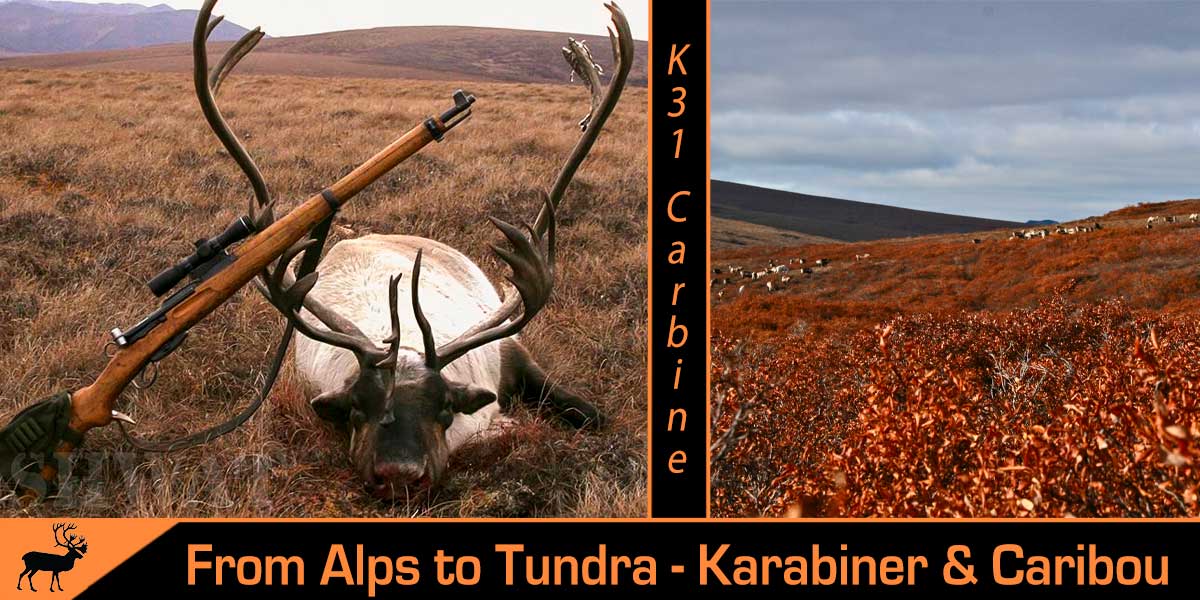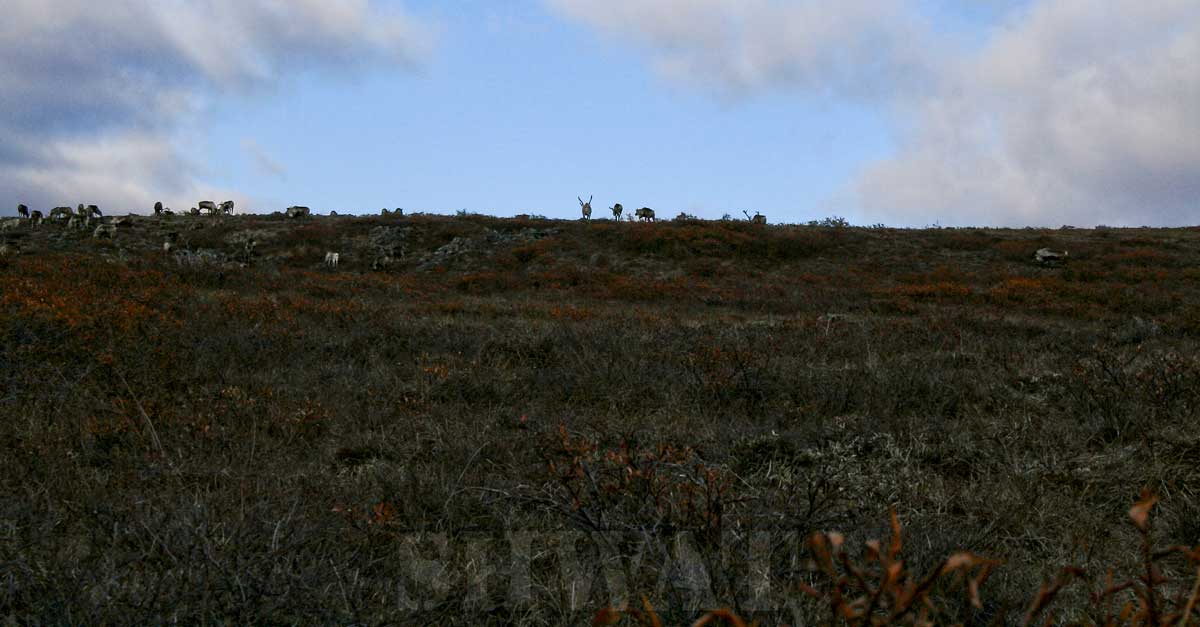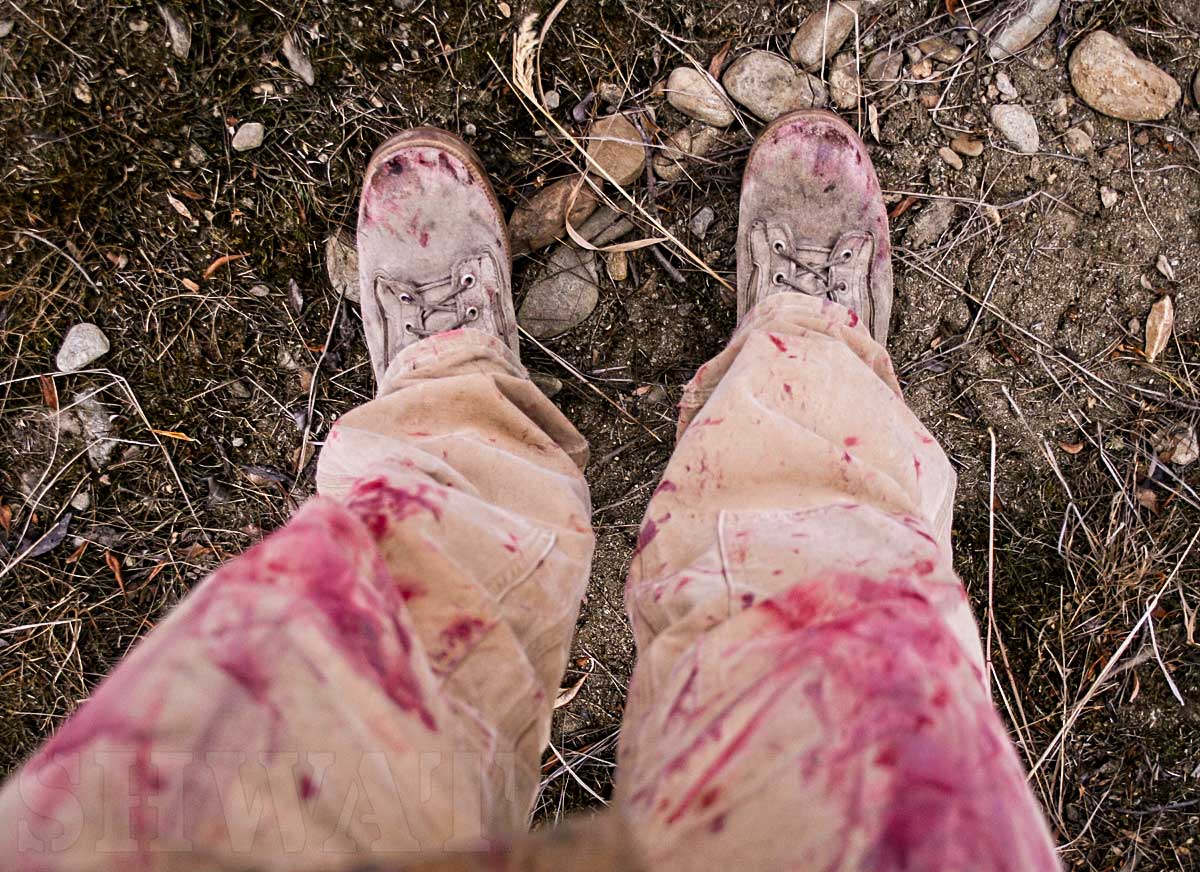
Slowly, careful to avoid spooking the suspicious old cows in the caribou herd in front of me, I unzipped my assault pack and slid my hand in. My fingers closed over . . . . nothing. Disgusted with myself, I shoved my rifle to the side and started crawling through the tundra in the diminishing evening light . . .
Alaskan Caribou Hunt
Climbing out of Bering Air’s Cessna, I ducked under the wing and walked around the plane to retrieve my rifle case from a belly compartment. In the case was a Swiss K31 rifle, a Ruger Vaquero revolver, and ammunition for them both.
The next morning I started out on a four-wheeler for some long-range hunting, but the weather wasn’t cooperating. Winds were holding steady at around 60 mph and gusting 10 to 20 mph higher. I had to downshift to make headway into the wind.
Temperatures were warm; in the high teens with no snow on the ground, warming to the high 20s with the rising of the sun.
By evening I had located a caribou herd on a wide tundra slope that rose from a river to a plateau. The grazing herd moved slowly uphill, illuminated by warm sunset rays against the copper hue of the tundra. The wind had dropped with the setting of the sun. I stalked to within 200 meters, rested my K31 on my assault pack, and chambered a 7.5x55mm cartridge.
The Problems Start
The cartridge was a custom hunting load that I was testing for a specialty ammo manufacturer. It was their first foray into loading this cartridge, and the recipe it was based on was for precision matches, not hunting. The soft-point bullet was loaded to touch the lands, with a very light crimp. I was unaware of this.
I now encountered my first problem. A long eye relief scope mounted on a scout mount is fast and intuitive, and this was my first test of the concept. The sun, settling into the weathered mountains behind me, poured its golden light directly onto the ocular lens of my scope. I could not even look at it. Shifting my position slightly, I cupped my hand over the scope and squinted through it. I could see, sort of. Problem solved. Sort of.
Aligning my reticle on the kill zone of a big bull, I stopped breathing, took up the first smooth stage, and then squeezed the trigger. The stock match trigger broke cleanly at two-and-a-half pounds, and the click of the firing pin was deafening.
Misfire.
Not a problem. I pulled straight back on the straight-pull bolt and saw the cartridge case rotating out as it ejected, unfired powder spilling from the open mouth as it turned. I knew where the bullet was – in the bore of my rifle.
Even worse. But still not so bad.
I had come prepared for issues with this untested ammo.
7.5×55 Ammo
The 7.5×55 is supported by some great European ammunition manufacturers. Many American ammo manufacturers offer a mediocre load or two for European cartridges as a half-hearted afterthought, but European companies develop outstanding loads for them.
One of my favorites is Norma, and I had a box of my go-to hunting cartridges for the 7.5 Swiss; Norma’s 180 gr. Oryx load. The Oryx bullet is a brilliant bonded-core bullet with a few tricks up its sleeve. Internal mechanical structure at the tip, combined with a bonding process that leaves the tip unbonded, results in rapid, broad expansion. Unlike other fast-expanding bullets, the Oryx retains over 90% of its weight and penetrates very deep and straight. I’ve learned to have absolute confidence in both the bullet and cartridge in these K31 rifles.
I rolled to my side, opened a compartment on my assault pack, and reached inside for my cleaning rod.
Do you carry a cleaning rod with you when you hunt? I do. I have used it to clean mud and snow and other debris out of people’s bores that otherwise would have cost them a hunting trip. This time, it would clear my bore of a stuck bullet.
But, this time, my hand closed on nothing. I had left my cleaning rod in my suitcase at the camp.
Now it was bad.
Time for New Tactics
Furious at myself, I looked toward the herd, which had moved to 250 meters off, at the open tundra between us, and the lengthening shadows. I pushed my K31 to the side and started to crawl.

I crawled to within 75 meters of the edge of the herd, but the herd had picked up speed, wanting to arrive at the top of the plateau before dark. They were strung out with only a few close to me. I drew my Ruger Vaquero and, aiming at a fat little cow, sent a heavy .45 Colt bullet spinning through the gathering dusk, dropping her in the last rays of legal shooting light.
After dressing the little cow in the dark, I headed back to camp, retaining her antlers also to use for crafts.
Back at camp, my cleaning rod tapped the bullet out of my bore and then went into my assault pack. The custom ammo disappeared into my suitcase. In the morning, six rounds of Norma Oryx 7.5 Swiss ammo went into my magazine. I headed out again. Winds were still high and stayed high. Shifting down to make headway against the higher gusts, I beat my way into the wind.
Round 2: Man vs. Caribou
By early afternoon, I had located the herd again, some distance from where they were the day before. They were up on a high tundra plateau and moving into the wind as they grazed or rested. With wind reaching 70 mph gusts, I did not dare to take a long shot. The herd was nervous and several old cows were very wary and on edge, pushing the herd along when it spent too much time in one place. It seemed that at least one of them was always looking my way, forcing my movement to be cautious.
I worked my way toward the herd, running quickly across depressions, then working my way carefully over high spots that the herd could see. By the time I reached a position close enough for shooting in that wind, the last of the herd was passing my position. I crawled backward until I had the cover of the terrain, and then ran a large circle into the wind as far as I dared without getting too far upwind of the herd. Again I cut the herd behind the last stragglers. Again I crawled back and ran a half-circle. Again the end of my circle maneuver just missed the tail end of the herd.
With the herd traveling fast and directly into a strong wind, and a lot of open high ground between myself and the caribou, I had quite the disadvantage – I couldn’t move too far forward of the herd or they would scent me, I could not move fast enough to get close to them before they passed, and I dared not take a 400 meter shot in these winds.
By evening, I was beginning to feel the effort of my stalk. I had been running and crawling for hours in a wind that had several times taken me off my feet, and often took my breath away. I looked shockingly bloodied, but it was only juice from crawling through blueberries.

The herd lay down again, including the restless old cows. This time they stayed down just long enough. I crawled closer until I felt confident shooting in the wind that had been battering me all day. Then a heavy gust knocked the confidence right out of me, and I crawled closer still. At about 175 yards I stopped again. Wind drift would still be somewhere around 23”. But I didn’t have my Kestrel wind meter, nor my rangefinder, so I was still doing a bit of guesswork on both range and windspeed. In those winds, just a few meters would make a difference of inches in point of impact.
My hand found the unorthodox bolt handle, but did not wrap around it. The flat of my hand pushed straight backward and the bolt unlocked smoothly and glided back. Reversing the angle of my hand, I pushed forward on the handle. The bolt beautifully stripped a Norma Oryx cartridge from the magazine and locked behind it. With the Swiss rifle stabilized across my assault pack, I placed my reticle almost two feet upwind from the center of the vital zone on a beautiful white bull. It wasn’t the largest bull in the herd, but I liked the color.
The bull, with the rest of the herd, was laying down, and I didn’t like the shot, through the tops of intervening low tundra plants, so I waited. One old cow began peering toward the area of my position. I don’t think she could pinpoint my position, but she sensed something was there and she didn’t like it.
She stood suddenly and stared pointedly in my direction. Several other old dames stood and gazed toward me. Heads swung back and forth as they searched for a threat. Noses tested the wind for a scent.
I saw restlessness ripple through the herd. The old cow began moving off, and other animals stood, then started to move. Still, the light bull lay in the reindeer moss and lingonberries. More animals began walking and the herd’s pace accelerated. The wind whipped across the undulating tundra hills, ripping away all sound but its own, flattening the tundra plants and brush, battering the right side of my body, shaking me even in my prone position.
I watched the chosen bull, alternating between looking past my scope and through it to keep on target. Finally, with the rest of the herd disappearing over a rise, a young cow next to the bull stood, and he followed her example. My reticle followed his movement. White and grey hair, whipped and rippled by the wind, flowed in the small world of my scope. Again my reticle settled about two feet upwind of the bull’s vitals and steadied. I waited for the wind to dip, but it remained steady. My finger found the curve of the trigger and took up the first smooth stage. My breathing stopped, my finger pressed straight back against the second stage, and the trigger broke lightly and cleanly, almost before I expected it.
I saw a hint of tufts of white hair flying away in the wind, and the bull stood still. My hand was already slapping back and forward on the bolt handle and in less time than it takes to say it, my finger found the trigger again. Second-guessing my calculations, I moved my reticle 6 inches further forward. The match trigger broke without disturbing the point of aim, and this time I saw the caribou flinch his shoulder muscles. Still, he stood, lowering his head slightly. I chambered a third cartridge and my finger was on the trigger again.
I had intended to shoot two or three caribou, but now the herd was trotting, the wind was blowing beyond my ability to expertly judge it, and my confidence in my ability to achieve clean kills completely evaporated in the crisp howling wind.
Before I fired the third shot, the wounded bull began to move. Slowly and deliberately, the bull lay back down in the tundra, front legs folded under first, then hind legs down. He continued looking forward while gently laying his chin down on the moss. He lay like that for a few seconds, then, as if his antlers were too heavy to support any longer, his head slowly lolled to the side until his right antler lay on the tundra and his sides stopped moving.
The rest of the herd was gone and I was alone with the motionless bull, the moaning wind, and endless waves of copper tundra stretching away in all directions. Abruptly, the wind died away.
I walked to the bull and lay my hand on its head, feeling gratitude for the opportunity to share the tundra with these creatures, to cross paths with them in the natural circles of life and death, and for the sacrifice of the animal to feed my family.
Norma Oryx Performance
My first bullet had hit the vital zone, but behind where I had intended, leaving an impressive exit wound. The second struck about 6 inches further forward and was under the skin on the far side leg, beautifully mushroomed. The caribou died where it had stood, and died quickly and with dignity. The Norma Oryx bullets had performed as expected. If you prefer American cartridges, the Norma Oryx .30-06 load is the ballistic twin of the 7.5 Swiss Oryx, with the .308 Oryx only a little behind in velocity.

I felt the smooth, scarred stock of the rifle in my hands, just as a young Swiss soldier, latitudes, meridians, and decades removed, must have felt it while standing on the slopes of the Alps. I appreciated the precision and accuracy of the rifle; the balance and the beauty.
And I appreciated the care that Cpl. Franz Erni, of Heavy Füsilier Company, 43rd Infantry Regiment, took in maintaining this rifle, while standing ready to defend the free world against evil in his day. He handed off his rifle with a perfect bore, and I once shot a half-minute group with iron sights. I can shoot similar groups any time with a scope mounted.
But this hunt soured me on a scout scope for these rifles. Why use a scout mount and low magnification when a standard scope can be mounted without damage on such a precision rifle? Upon returning home, I ordered a Swiss Products clamp-on scope mount, 11mm rings, and a Shepherd scope. It was not long before the rifle, thus configured, was dropping caribou again, this time at long range on the shores of the Arctic Ocean.
Perhaps you’d like to have your own Swiss K31. You can read my review on these precision masterpieces here on SHWAT.com.



